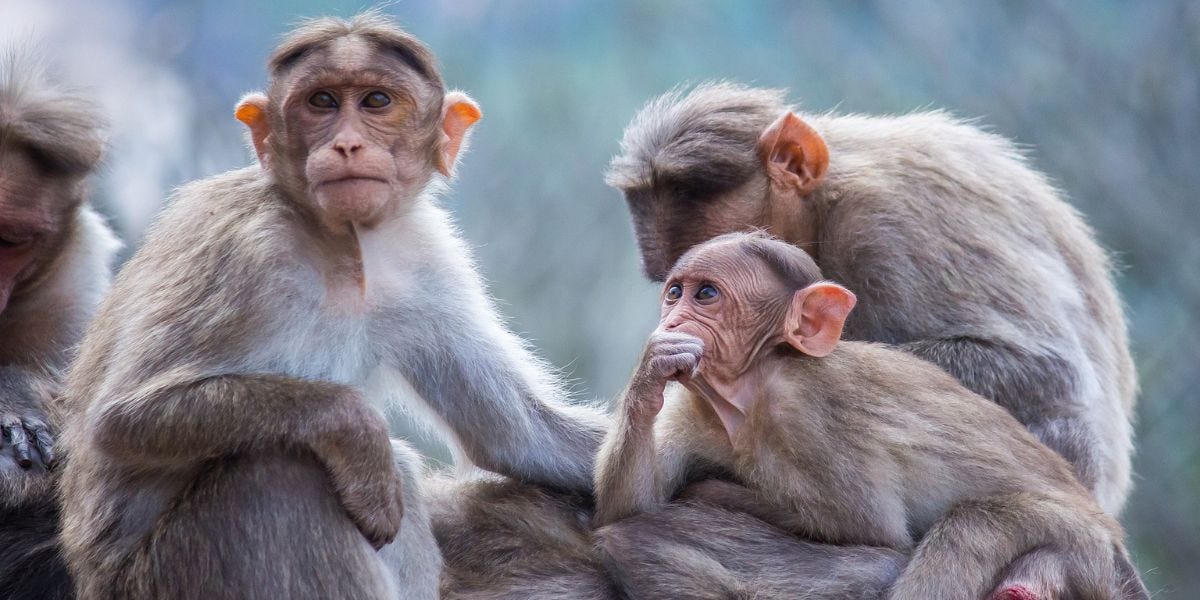Monkeys display a wide array of behaviors that reflect their intelligence and adaptability. These behaviors vary between species but often include:
- Social Structures: Monkeys are highly social animals, living in groups that can range from small family units to large troops. Social structures are typically hierarchical, with dominant individuals leading the group and influencing social interactions. Grooming is a common social activity that helps reinforce bonds and establish social hierarchies.
- Communication: Monkeys use vocalizations, facial expressions, and body language to communicate. For instance, velvet monkeys have specific alarm calls for different predators, which help coordinate group responses. Howler monkeys produce loud, resonant calls to communicate with distant group members.
- Tool Use: Certain monkey species are known for their use of tools. Capuchin monkeys, for example, use sticks to extract insects from crevices and stones to crack nuts. This behavior demonstrates their problem-solving abilities and cognitive skills.
- Playfulness: Many monkeys engage in play, which is crucial for social development and physical coordination. Play behaviors often involve chasing, wrestling, and swinging, and are observed in both young and adult monkeys.
Conservation Challenges
Despite their captivating nature, many monkey species face significant conservation challenges. Habitat loss, poaching, and illegal wildlife trade pose major threats to their populations.
- Habitat Destruction: Deforestation and land conversion for agriculture and urban development lead to the loss of monkey habitats. This not only reduces the available living space but also disrupts food sources and social structures.
- Poaching and Illegal Trade: Monkeys are targeted for bush meat, traditional medicine, and the exotic pet trade. Poaching and illegal wildlife trafficking contribute to population declines and disrupt ecological balances.
- Climate Change: Changes in climate patterns can affect the availability of food and suitable habitats for monkeys. Altered weather conditions can lead to food shortages and increased competition for resources.
Conservation Efforts
Efforts to protect and conserve monkey species involve a combination of strategies aimed at addressing the root causes of threats and promoting sustainable coexistence:
- Protected Areas: Establishing and maintaining protected areas is crucial for preserving monkey habitats. These areas help safeguard natural environments and provide safe havens for monkey populations.
- Anti-Poaching Measures: Implementing and enforcing anti-poaching laws, along with community-based conservation programs, can help reduce illegal hunting and trade. Educating local communities about the importance of wildlife conservation is also essential.
- Research and Monitoring: Ongoing research and monitoring of monkey populations and their habitats provide valuable data for conservation strategies. Understanding the behavior, health, and distribution of monkey species helps inform targeted conservation efforts.
- Public Awareness: Raising awareness about the plight of monkeys and the importance of their conservation can foster greater public support and involvement. Campaigns, educational programs, and media coverage play a vital role in promoting conservation initiatives.
Conclusion
Monkeys, with their diverse species, complex behaviors, and intriguing social structures, continue to captivate our imagination and offer valuable insights into the natural world. However, their survival is increasingly threatened by human activities and environmental changes. By supporting conservation efforts, protecting their habitats, and raising awareness, we can help ensure that these fascinating creatures continue to thrive in the wild, enriching our world with their presence and reminding us of the delicate balance of nature.
